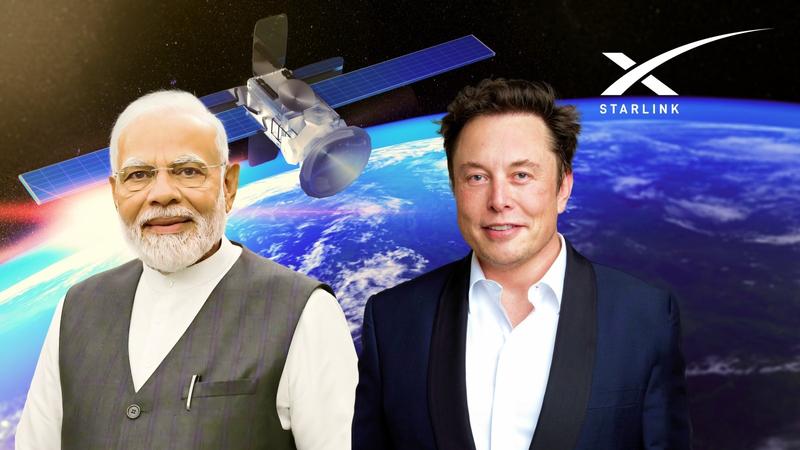Published 17:16 IST, April 16th 2024
Starlink Explained: How this Elon Musk-led venture can bridge India's digital divide
Starlink, spearheaded by SpaceX, aims to revolutionise internet access by leveraging a massive network of satellites orbiting Earth.

Starlink in India: The stage is set for the meeting between Tesla and Starlink founder - Elon Musk and the prime minister of India, Narendra Modi.
In the latest news, Elon Musk-led Starlink reportedly received an in-principle nod from the Ministry of Telecommunications, a major hurdle the company has cleared after over 3.5 years. Yes, that's right. This is not the first time Starlink is attempting to enter the Indian market.
The Regulatory Maze: A Hurdle from the Start
With nearly 920 million broadband subscribers, India presents a vast and dynamic market for internet access. However, traditional infrastructure struggles to reach remote areas, leaving millions without reliable connectivity. This is where Elon Musk's Starlink project enters the scene, promising high-speed internet delivered via a constellation of low-orbiting satellites. But Starlink's Indian ambitions face a complex interplay of regulatory hurdles, fierce competition, and potential geopolitical implications.
Starlink's Indian story began in 2021 with an attempt to enter the market. However, it immediately encountered regulatory challenges. The biggest hurdle was obtaining a Global Mobile Personal Communication by Satellite Services (GMPCS) license from the Telecom Regulatory Authority of India (TRAI).
But what is Starlink?
Starlink, spearheaded by SpaceX, aims to revolutionise internet access by leveraging a massive network of satellites orbiting Earth at a much lower altitude compared to traditional geostationary satellites. This proximity translates to significantly faster speeds and lower latency, making online activities like streaming, video conferencing, and remote work possible even in the most remote locations.
Simply put, Starlink aims to provide users access to the internet anytime and everywhere. Even airlines can offer passengers seamless connectivity during flights by installing Starlink hardware on aircraft.
Starlink's role in the ongoing conflict in Ukraine has garnered significant attention. By providing critical internet access to Ukraine's military and civilians amid disrupted communication channels, Starlink demonstrated its potential impact on global security.
Opportunities and challenges in India
India's digital landscape, while rapidly growing, suffers from stark geographical disparities. Millions in rural areas lack access to reliable internet, hindering education, healthcare delivery, and economic opportunities. Starlink, with its ability to bypass terrestrial infrastructure limitations, presents a compelling solution. It could empower rural communities, connect schools and hospitals, and enable the growth of remote businesses.
One major sticking point concerns spectrum allocation – the essential radio frequencies needed for satellite communication. Disagreements exist between Starlink and established players like Reliance Jio. Starlink favours administrative allocation, while Jio argues for auctions to ensure a level playing field. Resolving this debate will be critical for Starlink's operationalisation.
Starlink isn't the only player vying for a slice of India's satellite internet pie. Existing telecom giants are making strategic moves. For example, Reliance Jio has partnered with Luxembourg-based SES to offer satellite internet through its Jio Space Technology arm.
Bharti Airtel has a joint venture with OneWeb, another satellite internet company, to provide similar services.
These established players boast vast infrastructure networks and experience in the Indian market, posing a significant challenge to Starlink. Additionally, Amazon's Project Kuiper, though not yet operational in India, looms as a potential future competitor.
Modi-Musk Rendezvous: A meeting of minds
The upcoming meeting between Elon Musk and Prime Minister Modi on April 22, 2024 could be a pivotal moment for Starlink's Indian aspirations. Addressing regulatory concerns, reaching an agreement on spectrum allocation, and navigating the competitive landscape will be crucial.
Beyond connectivity
Starlink's potential impact extends beyond internet access. It has the potential to:
- Bridge the digital divide: By reaching remote areas, Starlink can empower communities, fostering education, healthcare, and economic opportunities.
- Revolutionise disaster response: Starlink's ability to provide internet access even in areas with damaged infrastructure can prove invaluable during natural disasters.
- Advance scientific research: Data collection and transmission from remote locations can be significantly enhanced with Starlink's capabilities.
Updated 17:23 IST, April 16th 2024



